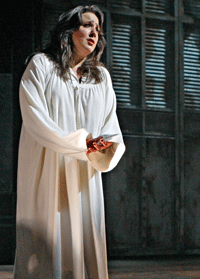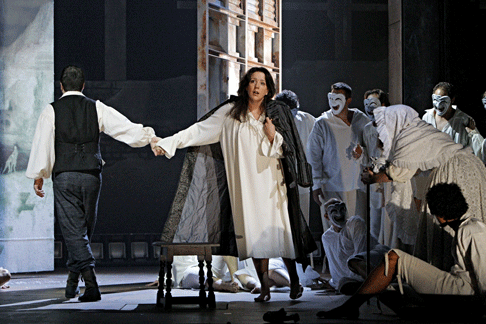![David Daniels as Orfeo [Photo by Michael Daniel courtesy of Minnesota Opera]](http://www.operatoday.com/0546.gif)
28 Sep 2010
Orpheo ed Eurydice in Minnesota
Minnesota Opera pulled out all the stops for its 2010-2011 season with its production of Gluck’s Orpheo ed Eurydice.
English Touring Opera are delighted to announce a season of lyric monodramas to tour nationally from October to December. The season features music for solo singer and piano by Argento, Britten, Tippett and Shostakovich with a bold and inventive approach to making opera during social distancing.
This tenth of ten Live from London concerts was in fact a recorded live performance from California. It was no less enjoyable for that, and it was also uplifting to learn that this wasn’t in fact the ‘last’ LfL event that we will be able to enjoy, courtesy of VOCES8 and their fellow vocal ensembles (more below …).
Ever since Wigmore Hall announced their superb series of autumn concerts, all streamed live and available free of charge, I’d been looking forward to this song recital by Ian Bostridge and Imogen Cooper.
Although Stile Antico’s programme article for their Live from London recital introduced their selection from the many treasures of the English Renaissance in the context of the theological debates and upheavals of the Tudor and Elizabethan years, their performance was more evocative of private chamber music than of public liturgy.
Evidently, face masks don’t stifle appreciative “Bravo!”s. And, reducing audience numbers doesn’t lower the volume of such acclamations. For, the audience at Wigmore Hall gave soprano Elizabeth Llewellyn and pianist Simon Lepper a greatly deserved warm reception and hearty response following this lunchtime recital of late-Romantic song.
For this week’s Live from London vocal recital we moved from the home of VOCES8, St Anne and St Agnes in the City of London, to Kings Place, where The Sixteen - who have been associate artists at the venue for some time - presented a programme of music and words bound together by the theme of ‘reflection’.
'Such is your divine Disposation that both you excellently understand, and royally entertaine the Exercise of Musicke.’
‘And there was war in heaven: Michael and his angels fought against the dragon; and the dragon fought and his angels, And prevailed not; neither was their place found any more in heaven … that old serpent … Satan, which deceiveth the whole world: he was cast out into the earth, and his angels were cast out with him.’
There was never any doubt that the fifth of the twelve Met Stars Live in Concert broadcasts was going to be a palpably intense and vivid event, as well as a musically stunning and theatrically enervating experience.
‘Love’ was the theme for this Live from London performance by Apollo5. Given the complexity and diversity of that human emotion, and Apollo5’s reputation for versatility and diverse repertoire, ranging from Renaissance choral music to jazz, from contemporary classical works to popular song, it was no surprise that their programme spanned 500 years and several musical styles.
The Academy of St Martin in the Fields have titled their autumn series of eight concerts - which are taking place at 5pm and 7.30pm on two Saturdays each month at their home venue in Trafalgar Square, and being filmed for streaming the following Thursday - ‘re:connect’.
The London Symphony Orchestra opened their Autumn 2020 season with a homage to Oliver Knussen, who died at the age of 66 in July 2018. The programme traced a national musical lineage through the twentieth century, from Britten to Knussen, on to Mark-Anthony Turnage, and entwining the LSO and Rattle too.
With the Live from London digital vocal festival entering the second half of the series, the festival’s host, VOCES8, returned to their home at St Annes and St Agnes in the City of London to present a sequence of ‘Choral Dances’ - vocal music inspired by dance, embracing diverse genres from the Renaissance madrigal to swing jazz.
Just a few unison string wriggles from the opening of Mozart’s overture to Le nozze di Figaro are enough to make any opera-lover perch on the edge of their seat, in excited anticipation of the drama in music to come, so there could be no other curtain-raiser for this Gala Concert at the Royal Opera House, the latest instalment from ‘their House’ to ‘our houses’.
"Before the ending of the day, creator of all things, we pray that, with your accustomed mercy, you may watch over us."
The doors at The Metropolitan Opera will not open to live audiences until 2021 at the earliest, and the likelihood of normal operatic life resuming in cities around the world looks but a distant dream at present. But, while we may not be invited from our homes into the opera house for some time yet, with its free daily screenings of past productions and its pay-per-view Met Stars Live in Concert series, the Met continues to bring opera into our homes.
Music-making at this year’s Grange Festival Opera may have fallen silent in June and July, but the country house and extensive grounds of The Grange provided an ideal setting for a weekend of twelve specially conceived ‘promenade’ performances encompassing music and dance.
There’s a “slide of harmony” and “all the bones leave your body at that moment and you collapse to the floor, it’s so extraordinary.”
“Music for a while, shall all your cares beguile.”
The hum of bees rising from myriad scented blooms; gentle strains of birdsong; the cheerful chatter of picnickers beside a still lake; decorous thwacks of leather on willow; song and music floating through the warm evening air.
![David Daniels as Orfeo [Photo by Michael Daniel courtesy of Minnesota Opera]](http://www.operatoday.com/0546.gif)
Minnesota Opera pulled out all the stops for its 2010-2011 season with its production of Gluck’s Orpheo ed Eurydice.
Early music veteran David Daniels alongside fresh-voiced soprano Susanna Phillips headline the production. Stage director Lee Blakeley, British designer Adrian Linford, and choreographer Arthur Pita collaborate to create a visually captivating production, tapping into classical and raw humanistic elements. And with the exceptional underpinnings of the St. Paul Chamber Orchestra under the direction of baroque specialist Harry Bicket, what can be missed?
 Susanna Phillips as Euridice
Susanna Phillips as Euridice
Set in a classical-style theater proscenium, the backdrop directly alludes
to Orpheus as the symbol of music, performance and art. Eurydice’s
funeral in Act I reveals the remains of the same theater, though decaying,
casting a darkened shadow on Orpheus’ future creative life without his
beloved. As Orpheus prepares to enter the gates of Hades to retrieve Eurydice
in Act II, he climbs into the backstage of the theater, where eerie stagehands
haul decrepit set pieces from the wings and fierce Furies lurk behind the door.
The Elysian Fields appear within the theater’s depths, casting bright
light on souls descending into the afterlife from red cords dropping from the
canopy. Orpheus and Eurydice travel from Hades to the land of the living,
returning to the decrepit backstage. Only after Amore restores Eurydice’s
life in Act III does the theater return to its original luster.
Under the direction of Arthur Pita, members of the Zenon Dance Company were a fantastic addition to this production. Implementing elements of modern dance throughout the longer orchestral interludes, the choreography perfectly reflected the musical topos. The choice of modern dance to complement the Classical music was a natural choice, considering Classical composers and performers of the time of Gluck were focused on recreating ancient Greek performance. Modern movement allowed the dancers to display the perfect proportions of the human form through raw and engaging movement without artifice. Pita’s use of dancers as the furies of Hades was a bold choice, considering this is the stormiest orchestral music of the opera. Barbarically clad monsters, tied to red cords leapt at Orpheus as he tries to enter the gates of Hades. The strong orchestral rhythms allowed the dancers to move with athleticism and virility, and were quite frightening to the audience! As the drama moves to the setting of the Elysian Fields, Pita makes more strong choices involving movement and dance. Dead souls slowly drop from the canopy, amplifying the languid transition from death to life. Once descended, the souls lose their human identity when they are forced to wear the mask of comedy. Pita’s choreography of one man’s soul losing his identity was some of the most raw yet fluid dancing of the evening.
 David Daniels as Orfeo, Susanna Phillips as Euridice and Company in The Minnesota Opera
David Daniels as Orfeo, Susanna Phillips as Euridice and Company in The Minnesota Opera
Counter-tenor David Daniels shined throughout the opera. Considering Orpheus is onstage from Act I to the end, Daniels commanded every moment in the performance. Throughout recitatives and ensemble sections, he communicated with an intense musical and theatrical focus both with his fellow performers and the audience. Daniel’s “Che faro senza Euridice” was the evening’s pièce de resistance. Daniel’s middle and upper registers had such power, easily cutting over the orchestra yet maintaining a beautiful lyricism, and the yearning lines of this aria truly pulled heartstrings. Certainly Amore wasn’t the only one moved by this masterful performance.
Susanna Phillips as Eurydice was a fantastic surprise. The twenty-nine year-old soprano has found much success since her 2005 Metropolitan Opera National Council Auditions win. With a golden voice, full of warmth and richness, she was able to beautifully maneuver through Gluck’s Baroque/ Classical style with finesse and ease. Considering she has much experience with Mozart, singing Donna Anna, Donna Elvira, Pamina, and the Countess, she executed refined tapered phrasing. Her breath agility was truly surprising during her Act III duet with Orpheo, where the voices are in perfect harmony. Shading her tone to complement Mr. Daniels was executed beautifully, both voices swelled and tapered through the harmonies, revealing beautiful simplicity in the straighter tones implemented. I hope Ms. Phillips continues to perform in these earlier genres, possibly foraying into Rameau or Handel.
 Angela Mortellaro as Amore
Angela Mortellaro as Amore
Minnesota Opera’s Resident Artist, Angela Mortellaro, played a
spritely pants role as Amore, the god of love. Ingeniously clad in a blindfold
and blind cane, Mortellaro cleverly uses her props to mock Gluck’s
interlude orchestral music, imitating rhythms with her cane. Ms.
Mortellaro’s voice has a silvery, glistening quality, and her upper
register shot through the hall with ease. Much of her recitative lay in the
lower register, and was not quite as audible. However, due to maybe one or two
stands too many in the orchestra, an overpowering orchestra in some sections
seemed to be an issue for the other performers as well.
The Minnesota Opera Chorus was a bit disappointing in this production. There was a large gap in performance intensity from the beginning with Mr. Daniels juxtaposed with the chorus in the opening funeral scene. It seemed as though the ensemble members were an energy drain onstage, with little to no commitment to their individual character, as well as lacking diction and musical intensity. With so many outstanding performers, the chorus could have used more theatrical coaching and diction work to bolster the ensemble to the level of the rest of the performance.
Sarah Luebke